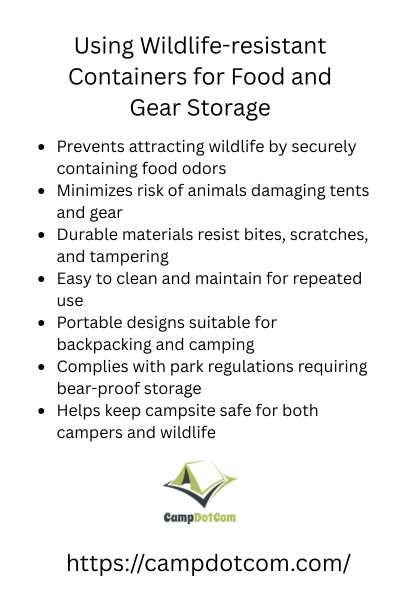Using wildlife resistant containers for storing food and gear is not only a smart choice, it is the kind of decision that can make or break your camping trip. I learned this lesson the hard way during a trip to the Smokies when a very determined raccoon decided my trail mix was his personal buffet. In the end, he won.
The truth is, wildlife getting into your food is more than just annoying; it can be dangerous for both you and the animals. So let us talk about why these containers are so valuable and how you can use them without feeling like you have suddenly joined a bear proof storage club.
Read More About Using Wildlife-resistant Containers for Food and Gear Storage

Why Bother With Wildlife-resistant Containers?
I get it. At first, you might think, “Eh, I’ll just hang my food in a tree” or “That little zipper pouch will do.” Trust me, wildlife-resistant containers exist for a reason. Bears, raccoons, squirrels—heck, even a particularly bold chipmunk—can smell your snacks from a mile away.
As an Amazon Associate, I earn from qualifying purchases. Some of the links in this article are affiliate links. This means that, at zero cost to you, I will earn an affiliate commission if you click through the link and finalize a purchase.
When you’re using wildlife-resistant containers for food and gear storage, you’re doing two big things:
1. Protecting your food and supplies from getting stolen (or contaminated)
2. Keeping wildlife from associating humans with an all-you-can-eat buffet
Plus, you’re not waking up to find your tent neighbor angrily waving your granola bar wrapper because it somehow blew into their camp.
More Things to Know About Using Wildlife-resistant Containers for Food and Gear Storage

My First “Wildlife Container” Experience
Picture this. It is my first multi day backpacking trip. I am feeling pretty proud of myself with the tent set up, campfire crackling, and dinner ready. I tuck my food bag neatly under my camp chair. That was a rookie mistake.
Around two in the morning, I wake up to the sound of crinkling plastic. Not the soft kind, but the kind that says, “I am tearing this open like my life depends on it.” I unzip my tent and find a raccoon halfway into my food stash, looking like he just won the lottery.
The next morning, a fellow camper handed me a bright yellow wildlife resistant container and said, “You will thank me later.” He was right. I never camp without one now.
Choosing the Right Container
When using wildlife-resistant containers for food and gear storage, you’ve got options. Some are hard-sided—think mini vaults for your trail mix. Others are soft-sided but still tough enough to keep critters out.
Ask yourself:
– Are you hiking to your campsite or car camping? (Weight matters!)
– How much food and gear do you really need to store?
– Will it need to survive a bear encounter or just keep raccoons out?
Pro tip: Look for containers certified by the Interagency Grizzly Bear Committee (IGBC). If it’s bear-proof, it’s raccoon-proof, squirrel-proof, and “oops-I-dropped-it-off-a-cliff” proof.
How to Use Them Effectively
Having the container is one thing—using it right is another.
First, store it at least 100 feet from your tent. You don’t want a curious bear sniffing around your sleeping bag because you decided to keep your beef jerky close. Second, seal it properly every time. One loose latch and you’ve basically put up a neon “Free Snacks” sign.
And here’s a bonus: using wildlife-resistant containers for food and gear storage isn’t just for food. You can stash toiletries, cookware, and even trash. If it smells interesting to you, it smells like a feast to wildlife.
But Are They Worth the Effort?
Absolutely. Think about it. Would you rather carry a container that adds a few extra pounds to your pack, or lose your only dinner on the second night of a four day trip?
There is also real peace of mind in knowing your food is safe. You can sit back and enjoy the campfire without constantly scanning the shadows for a bear with a peanut butter obsession.
Mistakes to Avoid
A lot of folks think they’re being clever by “hiding” food in their tent. I promise you, wildlife can smell through nylon. It’s basically like wrapping a cheeseburger in tissue paper and thinking no one will notice.
Another mistake? Forgetting that gear storage matters too. I’ve seen squirrels chew through backpacks to get at a single protein bar. Don’t give them a reason—put everything with a scent into the container.
Keep Wildlife Away from Your Campsite with Secure Food Storage
Here’s the thing, camping and backpacking are so much more fun when you are not worried about curious animals stealing your breakfast. Using containers that are designed to keep wildlife out is a simple step that can make a big difference.
You will keep your food safe, protect wildlife, and avoid becoming the camper with the backpack that got torn apart. And who knows, you might even start to feel a little proud of that bright, bulky container because it means you are camping smart.
So, the next time you pack for an adventure, be sure to include one of these containers. Your trail mix will be glad you did.
